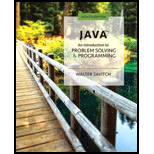
The Fibonacci sequence occurs frequently in nature as the growth rate for certain idealized animal populations. The sequence begins with 0 and 1, and each successive Fibonacci number is the sum of the two previous Fibonacci numbers. Hence, the first ten Fibonacci numbers are 0, 1, 1, 2, 3, 5, 8, 13, 21, and 34. The third number in the series is 0 + 1, which is 1; the fourth number is 1 + 1, which is 2; the fifth number is 1 + 2, which is 3; and so on.
Besides describing population growth, the sequence can be used to define the form of a spiral. In addition, the ratios of successive Fibonacci numbers in the sequence approach a constant, approximately 1.618, called the “golden mean”. Humans find this ratio so aesthetically pleasing that it is often used to select the length and width rations of rooms and postcards.
Use a recursive formula to define a static method to compute the nth Fibonacci number, given n as an argument. Your method should not use a loop to compute all the Fibonacci numbers up to the desired one, but should be a simple recursive method. Place this static recursive method in a
Fibonacci #1 = 0
Fibonacci #2 = 1
Fibonacci #3 = 1; 1/1 = 1
Fibonacci #4 = 2; 2/1 = 2
Fibonacci #5 = 3; 3/2 = 1.5
Want to see the full answer?
Check out a sample textbook solution
Chapter 11 Solutions
Java: An Introduction to Problem Solving and Programming (8th Edition)
Additional Engineering Textbook Solutions
Starting Out with Java: From Control Structures through Objects (7th Edition) (What's New in Computer Science)
Starting Out with Python (4th Edition)
INTERNATIONAL EDITION---Engineering Mechanics: Statics, 14th edition (SI unit)
Introduction To Programming Using Visual Basic (11th Edition)
Web Development and Design Foundations with HTML5 (8th Edition)
Elementary Surveying: An Introduction To Geomatics (15th Edition)
 C++ for Engineers and ScientistsComputer ScienceISBN:9781133187844Author:Bronson, Gary J.Publisher:Course Technology Ptr
C++ for Engineers and ScientistsComputer ScienceISBN:9781133187844Author:Bronson, Gary J.Publisher:Course Technology Ptr C++ Programming: From Problem Analysis to Program...Computer ScienceISBN:9781337102087Author:D. S. MalikPublisher:Cengage Learning
C++ Programming: From Problem Analysis to Program...Computer ScienceISBN:9781337102087Author:D. S. MalikPublisher:Cengage Learning EBK JAVA PROGRAMMINGComputer ScienceISBN:9781337671385Author:FARRELLPublisher:CENGAGE LEARNING - CONSIGNMENT
EBK JAVA PROGRAMMINGComputer ScienceISBN:9781337671385Author:FARRELLPublisher:CENGAGE LEARNING - CONSIGNMENT- Np Ms Office 365/Excel 2016 I NtermedComputer ScienceISBN:9781337508841Author:CareyPublisher:CengageProgramming Logic & Design ComprehensiveComputer ScienceISBN:9781337669405Author:FARRELLPublisher:Cengage
 Systems ArchitectureComputer ScienceISBN:9781305080195Author:Stephen D. BurdPublisher:Cengage Learning
Systems ArchitectureComputer ScienceISBN:9781305080195Author:Stephen D. BurdPublisher:Cengage Learning





